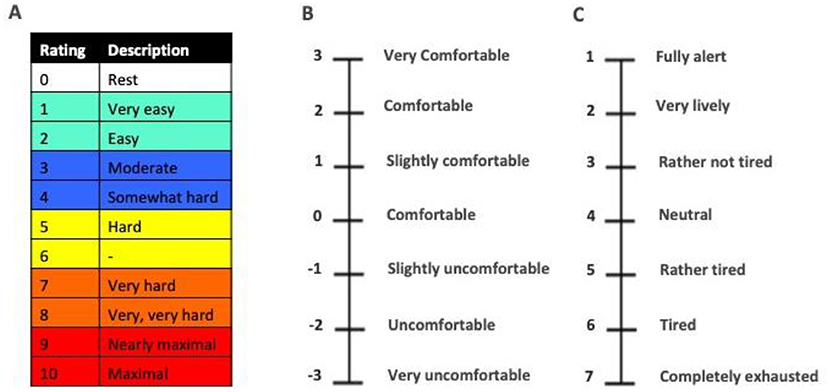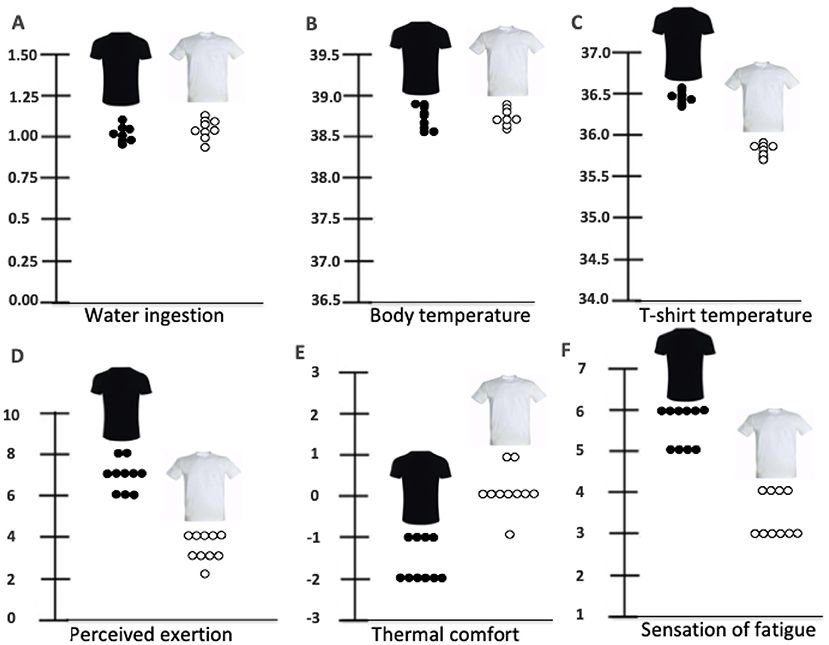Abstract
Many tennis competitions take place in hot environments when the sun is shining. So tennis players must train in the heat to learn how to perform in hot conditions. Although they may be advised to wear light-colored clothing, many players wear black T-shirts during training and competitions. This study, carried out with young, skilled tennis players, investigated whether T-shirt color (black or white) had any impact on players. During two training matches in the heat (32°C), we measured the air and T-shirt temperatures, how hard players felt like they were working, how comfortable they felt with the environment, and how tired they felt. Results showed that, when playing tennis outdoors in the heat, T-shirt color has no impact on physical factors like temperature. However, wearing a black T-shirt can negatively impact mental factors by increasing athletes’ feelings of working hard, tiredness, and discomfort.
Does T-Shirt Color Matter for Athletes?
During physical activity, such as tennis training or matches, the player’s muscles produce heat that must be escape from the body to maintain a steady body temperature. Heat is released by an increase in heart rate, which allows heat to move from the muscles into the skin. When it is not too hot, body heat is eliminated through sweating, and the body temperature stabilizes at around 38.5°C after ~45 min of play [1].
However, playing tennis in hot environments is physically demanding [2]. The combination of physical activity and heat stress leads to a bigger increase in body temperature, which can exceed 39.5°C [3] and can decrease performance. Coaches often suggest wearing light-colored clothing to limit the effects of sunlight, because black absorbs more heat, which can be transmitted to the skin. However, to our knowledge, no studies have investigated the effects of T-shirt color in young tennis players. The aim of this study was to evaluate the influence of T-shirt color on athletes playing a tennis match in the heat. We looked at the effect on skin and T-shirt temperatures, water ingestion, and athletes’ feelings about how hard they were working (called exertion), thermal comfort, and fatigue.
Studying Tennis Players in the Heat
Ten skilled young males (mean age 18.1 years) who had been playing tennis for more than 10 years volunteered to participate in this study. They participated in two tennis sessions wearing either a white or a black cotton T-shirt. Each session included a 15-min warm-up followed by 60 min of play in match conditions. The sessions began at 2:00 p.m. and the mean temperature on the tennis court was 31.8°C.
Outdoor, body, and T-shirt temperatures were measured using thermometers before playing, every 15 min during the matches, and after the matches. To measure the intensity of physical activity, a scale called the Borg Rating of Perceived Exertion (RPE) was used [4], which asks athletes how hard they feel like their bodies are working (Figure 1A). Players used other scales to describe their thermal comfort (Figure 1B) and feelings of fatigue (Figure 1C) at the same time periods. At the end of the matches, the volume of water each athlete consumed was also recorded.

- Figure 1 - In our study, we asked the volunteers to rate their experience playing tennis in the heat using three separate scales.
- (A) The Rating of Perceived Exertion (RPE) measures how hard you feel your body is working when you exercise. (B) The thermal comfort scale measures how hot or cold you feel, and if you feel comfortable or not. (C) The feeling of fatigue scale measures how tire or low on energy you feel.
What did We Find?
Whether athletes were wearing a white or a black T-shirt, their water intake (about 1.2 L) and body temperatures were similar. However, T-shirt temperature was higher when wearing a black rather than a white T-shirt. In addition, perceived exertion, feelings of fatigue, and thermal discomfort were lower when athletes wore a white T-shirt compared to a black T-shirt (Figures 2, 3).

- Figure 2 - (A) Water ingestion (L) was approximately the same regardless of T-shirt color.
- (B) Body temperature (°C) was approximately the same regardless of T-shirt color. (C) T-shirt temperature (°C) was higher for black shirts. (D) RPE was higher for athletes wearing black shirts. (E) Thermal comfort was lower for athletes wearing black shirts. (F) Feelings of fatigue were higher for athletes wearing black shirts. Each dot indicates an individual athlete.

- Figure 3 - Perceived exertion, thermal comfort, and feelings of fatigue were measured before playing (T0), every 15 min during the match (T15–T60), and after the match (T75).
- (A) Perceived exertion got higher during the exercise and was stronger when players wore a black-T-shirt. (B) Thermal comfort got lower during the exercise and was worse when the players wore a black T-shirt. (C) Feelings of fatigue got stronger during the exercise and where higher for participants wearing black shirts. Overall, this indicates that perceived exertion, feelings of fatigue, and thermal discomfort were higher when athletes wore black T-shirt compared to a white T-shirt.
T-Shirt Color Matters!
Although the color of the T-shirt had no impact on physical factors such as body temperature or water intake when playing tennis outdoors in the heat, this study revealed that wearing a black T-shirt can have a negative impact on mental factors. Tennis players had a higher perception of exertion (they felt like it was hard to play), higher feelings of fatigue (they felt tired) and lower thermal comfort (they found the environment uncomfortable) when wearing a black T-shirt vs. a white T-shirt [5]. Although players indicated that they never paid attention to the color of their outfits when playing tennis in the heat, the differences we observed could be a result of the common belief that wearing a black T-shirt makes you more hot and tired than wearing a white T-shirt does. Overall, our results suggest that it is best for athletes to wear light-colored clothing, which can limit the effects of sunlight. Black clothing can absorb more heat that could be transmitted to the skin and may increase discomfort and feelings of fatigue [2, 5].
In conclusion, our results suggest that the color of a T-shirt affects tennis players mentally but not physically. We strongly suggest that athletes who train during the hottest hours of the day (i.e., between 10:00 a.m. and 5:00 p.m.) outdoors in a hot environment should wear light-colored clothing to limit the negative effect of heat stress on mental factors. We also suggest changing the T-shirt when it is very damp to limit discomfort, regularly drinking fresh water or a sports beverage (15 centiliters, between 5 and 15°C, every 15 min) and taking regular breaks to limit the negative effects of the heat.
Glossary
Exertion: ↑ It means how hard your body is working during an activity. It can feel easy, a little hard, or very hard, like when you are running or lifting something.
Thermal Comfort: ↑ The state of mind that expresses satisfaction with the environment and can be assessed by a rating scale.
Fatigue: ↑ It means feeling very tired or having low energy. The feeling of fatigue scale helps show how tired you feel, from full of energy to extremely tired.
Borg Rating of Perceived Exertion (RPE): ↑ An indicator of the intensity level and sensations (e.g., increased heart rate, respiration, sweating, and muscle fatigue) experienced during sports based on a rating scale.
Conflict of Interest
The authors declare that the research was conducted in the absence of any commercial or financial relationships that could be construed as a potential conflict of interest.
Acknowledgments
The authors would like to thank the tennis players (i.e., Jonas, Martin, Richard, Théo, Nils, Axel, Robbin, Cédric, Yohan and Rubben) for participating in this study.
AI Tool Statement
The author(s) declare that no Gen AI was used in the creation of this manuscript.
Any alternative text (alt text) provided alongside figures in this article has been generated by Frontiers with the support of artificial intelligence and reasonable efforts have been made to ensure accuracy, including review by the authors wherever possible. If you identify any issues, please contact us.
Original Source Article
↑Robin, N., Carien, R., Dominique, L., and Ruart, S. 2024. Black outfit negatively impacts psychological factors of tennis players in tropical environment. Mov. Sport Sci. 127:29–39. doi: 10.1051/sm/2023024
References
[1] ↑ Martin, C. 2018. Tennis: Performance Optimization. Louvain-la-Neuve: De Boeck Supérieur.
[2] ↑ Robin, N., Dominique, L., and Coudevylle, G. R. 2021. Playing tennis in hot environment: applied strategies and new directions. ITF Coach. Sport Sci. Rev. 83:10–3. doi: 10.52383/itfcoaching.v29i83.47
[3] ↑ Robin, N., Hermand, E., Hatchi, V., and Hue, O. 2023. Heat management strategies and high level sports performance: psycho-physiological insights and applied recommendations. Sci. Sports 38:683–94. doi: 10.1249/00005768-197300520-00017
[4] ↑ Borg, G. A. 1973. Perceived exertion: a note on “history” and methods. Med. Sci. Sports 5:90–3.
[5] ↑ Robin, N., Carien, R., Dominique, L., and Ruart, S. 2024. Black outfit negatively impacts psychological factors of tennis players in tropical environment. Mov. Sport Sci. 127:29–39. doi: 10.1051/sm/2023024
